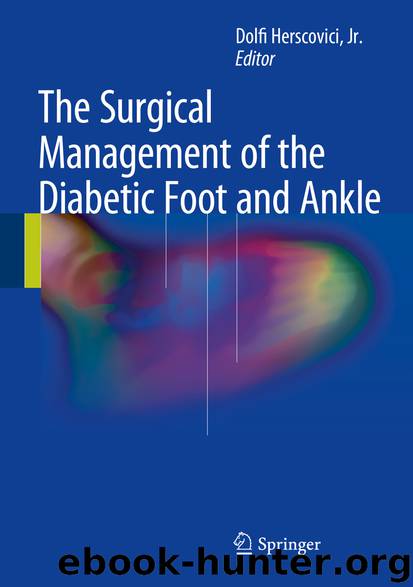The Surgical Management of the Diabetic Foot and Ankle by Dolfi Herscovici

Author:Dolfi Herscovici
Language: eng
Format: epub
Publisher: Springer International Publishing, Cham
Sanders/Frykberg Type V Pattern (Calcaneus)
Rarely, does CN develop in the hindfoot as an isolated entity. It is estimated that approximately 1 % of all CN fractures occur in the calcaneus (Sanders Frykberg Type V). By definition, these do not involve the subtalar joint (Figs. 7.1 and 7.6). The majority of these fractures may be treated with offloading in a cast or walker for 6–12 weeks (Fig. 7.4). Chronic ulcerations and bony prominences leading to skin necrosis have to be debrided according to the individual pattern of deformity. Of particular challenge is an acute calcaneal fracture that presents with an ulceration of the heel. However, good outcomes can be obtained with complete healing of both the fracture and ulceration after serial deep debridements and a prolonged course of offloading in a TCC has been used (Fig. 7.9). Patients are seen on an outpatient basis at least once a week until complete wound healing. After soft-tissue and bone consolidation, weight-bearing is gradually increased in a special boot or walker, depending on the patient’s compliance.
Using conventional internal fixation for the treatment of these patients will invariably be prone to failure. Implants usually fail and lead to further bony and soft-tissue complications (Fig. 7.10). In the author’s opinion, in the presence of CN only open calcaneal fractures or grossly displaced fractures with severe deformity of the hindfoot and direct compromise to the soft tissues should be treated operatively. Depending on the size of the fragments fixation may be obtained using combinations of short plates, screws, tension band wiring, or suture anchors [28, 39]. Most fractures are extra-articular, and involve the posterior tuberosity of the calcaneus. This allows fixation to be achieved using minimal incisions or with percutaneously placed screws. Because the Sanders/Frykberg type V lesions are either completely extra-articular or only marginally involve the subtalar joint, additional joint trans-articular fixation or fusion is usually not needed. Rather, these additional procedures only add to surgical trauma and are prone to complications like infection or non-union of the attempted arthrodesis [21, 23]. Alternatively, a small or fragile posterior tuberosity fragment may be excised and the Achilles tendon reattached to the calcaneus if it inserted on the fragment. In case of an open fracture, the decision to partially or totally resect a fractured fragment can be made in order to achieve wound closure without any tension on the wound edges.
Fig. 7.10A 59-year-old female patient with insulin-dependent diabetes had been treated with open reduction and screw fixation for a neuropathic calcaneal fracture. (a) She presented with a full thickness skin necrosis over the posterior tuberosity because of a non-union and complete redislocation of the fracture due to the pull of the Achilles tendon. Treatment consisted in resection of the displaced fragment and repeated debridements until soft-tissue closure became possible (b)
Download
This site does not store any files on its server. We only index and link to content provided by other sites. Please contact the content providers to delete copyright contents if any and email us, we'll remove relevant links or contents immediately.
When Breath Becomes Air by Paul Kalanithi(7264)
Why We Sleep: Unlocking the Power of Sleep and Dreams by Matthew Walker(5642)
Paper Towns by Green John(4169)
The Immortal Life of Henrietta Lacks by Rebecca Skloot(3826)
The Sports Rules Book by Human Kinetics(3588)
Dynamic Alignment Through Imagery by Eric Franklin(3489)
ACSM's Complete Guide to Fitness & Health by ACSM(3469)
Kaplan MCAT Organic Chemistry Review: Created for MCAT 2015 (Kaplan Test Prep) by Kaplan(3423)
Introduction to Kinesiology by Shirl J. Hoffman(3301)
Livewired by David Eagleman(3123)
The River of Consciousness by Oliver Sacks(2992)
Alchemy and Alchemists by C. J. S. Thompson(2912)
The Death of the Heart by Elizabeth Bowen(2902)
Descartes' Error by Antonio Damasio(2732)
Bad Pharma by Ben Goldacre(2730)
Kaplan MCAT Behavioral Sciences Review: Created for MCAT 2015 (Kaplan Test Prep) by Kaplan(2492)
The Gene: An Intimate History by Siddhartha Mukherjee(2491)
The Fate of Rome: Climate, Disease, and the End of an Empire (The Princeton History of the Ancient World) by Kyle Harper(2436)
The Emperor of All Maladies: A Biography of Cancer by Siddhartha Mukherjee(2431)
